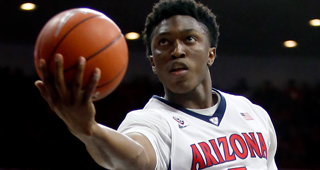Two years ago at adidas Nations and a year ago at the Nike Hoop Summit, Stanley Johnson was comfortably the best wing prospect at both. Context matters far more than we sometimes remember and Johnson was competing against a stacked deck if we compare his college resume to Justise Winslow. Johnson and Kevon Looney were on Jahlil Okafor’s team at Nations and both players would surely have the “winner” label had they had that Winslow role at Duke this past season. Johnson is as tough and competitive as any player in this draft.
Johnson can score in a multitude of ways with his blend of strength and quickness from the wing. Johnson has the mentality and body of a big to pair with the traditional skill-set of a wing with his perimeter shooting.
Johnson shot 74.2 percent from the line and 37.1 percent on three-pointers during his freshman season, which compares to James Harden’s first season at Arizona State. Johnson can approximate the classic Harden approach since he has the footwork to operate in the midrange and the strength to absorb fouls and still finish. Like Harden, it’s more about finding space to finish lay-ups than really attacking the rim in the halfcourt. Johnson is more adept with his pre-dribble jab steps to create space than he is simply losing his man off the dribble in isolation.
Johnson had nearly identical assist, turnover, usage and offensive rebound rates as Luol Deng’s freshman season at Duke. A lot of the halfcourt moves off the dribble and mid-post from Deng at Duke closely resemble Johnson’s tape. Johnson isn’t as good of a shot creator for others as he is for himself, as he seems to lock in on what he wants to do regardless of how he’s defended and that turns into low percentage shots and missed opportunities for easy buckets.
The Draymond Green comparisons are timely and fitting, but Johnson isn’t quite as long with an 8’6 standing reach compared to Draymond’s 8’9. The margins are narrow for a small-ball power forward and those three inches are the difference between being able to play the role part time and full time.
Johnson projects more as a better and stronger version of Harrison Barnes on defense with his versatility. Johnson is best suited to defend wings, but he’s certainly capable of defending up. Johnson can become a suffocating on-ball defender on the wing with his motor, strength and his wide frame.
Johnson can even become a safe and sane version of Ron Artest with more verticality and better perimeter scoring. That’s a high bar and has to come from the consistent persistence over an 82-game season that Artest brought to the game in his prime. The low end of Johnson’s potential is really high as a 3-and-D wing that can also defend small-ball 4’s.




